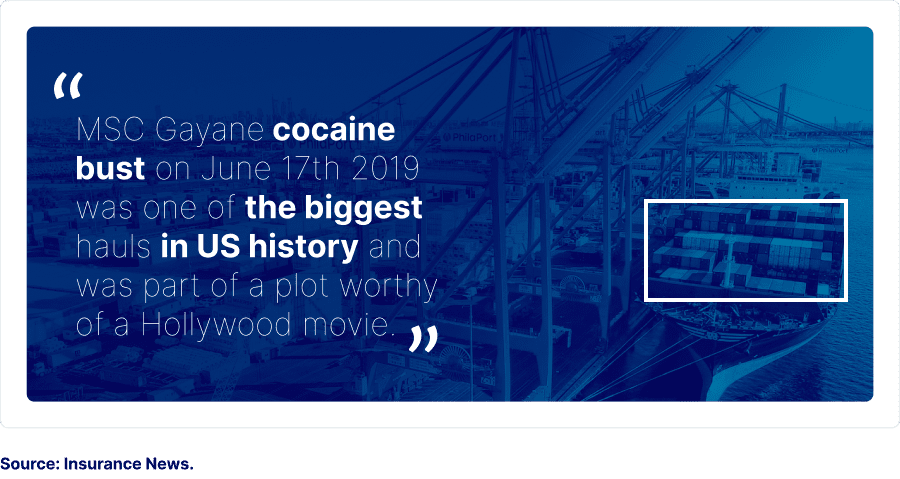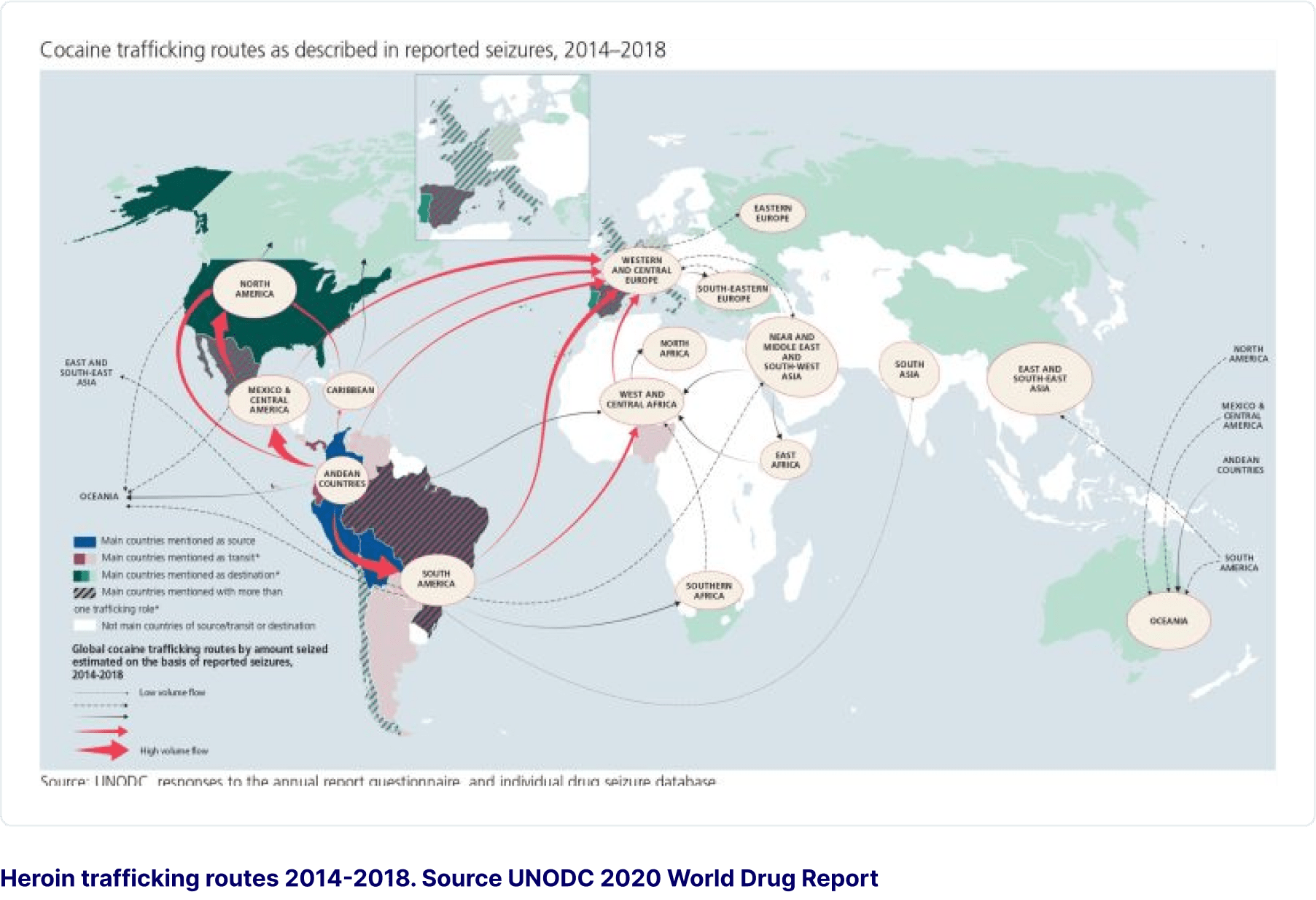January 10, 2022 5 Minute Read
Understanding the MSC Gayane Cocaine Smuggling Incident
More than two years after a record 20 tons of cocaine worth $1 billion was found aboard the container ship MSC Gayane when it docked in Philadelphia in June 2019, the U.S. prosecution of eight seafarers involved in the incident is finally over.
The Scale of the Smuggling Operation
‘This amount of cocaine could kill millions – MILLIONS – of people,’ – U.S. Attorney William McSwain.
Ever since this incident was reported, the maritime industry has marveled at the scale of the smuggling operation and wondered aloud how it was carried out. How was that much cocaine — the weight equivalent of three fully grown male African elephants — sneaked onto one ship when it was underway at sea, not berthed in port? How did more of the crew, and the captain, not know what was going on? And how did the conspirators know exactly which containers to hide the cocaine in so drugs would not be unloaded in the wrong port?
Recruitment and Execution: Inside the Smuggling Plot
The government investigation report, together with additional disclosures in the court docket of the sentenced crew, provide answers to these questions.
- Four of the crew were recruited by a criminal organization in Montenegro before they boarded the ship: chief mate Markovic, second mate Durasevic, engineer cadet Ilic and electrician Kavaja.
- After these four conspirators were at sea aboard the MSC Gayane, they recruited four additional crew members into the smuggling operation: fourth engineer Penda, assistant reefer man Bojevic, ordinary seaman Pulu and able seaman Tiasaga.
- They (onboard conspirators) used “narco phones” (encrypted instant messaging devices) to communicate with co-conspirators on land.
- The container vessel left its previous port in Europe “Clean” and sailed across the Atlantic, through the Panama Canal and down the western coast of South America. As it sailed southward after transiting the canal, it was met on multiple occasions in the Pacific at night by speedboats.
- Smugglers in the speedboats loaded duffel bags full of cocaine bricks into nets that were hoisted onto the vessel by the onboard conspirators using the provision crane at the ship’s aft.
- Markovic, the chief mate, who was in charge of the cargo plan, knew which containers would unload at which ports. The gang had a cache of fake seals. They broke the original seal, loaded the drugs into containers that were ultimately destined for Europe, and resealed the containers using the fake seals.
- When the MSC Gayane arrived at Philadelphia, authorities boarded the ship for a routine screening, and detected anomalies while examining seven shipping containers on board. Searching the ship, they found 19.76 tons of cocaine in those seven boxes.
Detection and Consequences in Philadelphia
Was there also cocaine smuggled aboard the MSC Gayane on the prior voyage — an operation that successfully delivered the goods?
When agents swarmed the ship in Philadelphia, they found a stack of 50-euro notes hidden in a carton of cigarettes in Tiasaga’s cabin. According to the investigation report, “Tiasaga informed agents that the money was a partial payment for helping bring cocaine on board the ship on a previous voyage.”
The Financial Fallout for MSC
As a result, MSC was suspended for 90 days from the Customs and Border Protection (CBP) “trusted trader” C-TPAT programme.
The US government also targeted the MSC Gayane with a forfeiture action. MSC placed $10m in a CBP security account and provided CBP with a $40m surety bond in order to release the ship.
MSC confirmed in a letter to US District Court Judge Harvey Bartle III that it had “suffered significant financial and reputational damage” as a result of the incident. The consequences included more than $100m in additional security costs.
Ongoing Challenge of Maritime Drug Trafficking
The scale of this particular incident is unusual, however over time the Maritime Industry has seen many different attempts being made to use commercial ships as a drug mule.
In its World Drug Report 2020, the United Nations Office on Drugs and Crime (UNODC) states that illicit drug use has been on the increase in the five-year period to 2019. UNODC seizure data indicates that most of the cocaine available in European drug markets is smuggled to Europe by sea.
How Can Technology Help to Prevent Drug Trafficking?
Trading in certain parts of the world will put a vessel and its crew at risk of being victims of drug trafficking. There is no magic solution in preventing a determined trafficker. However, there are measures that can be taken to minimize the risks.
Industry best practices suggest that the master and crew shall take all possible precautions to limit access to the vessel and monitor the surrounding area adjacent to the vessel while in port, such as:
- Enforcing single entry points onto the vessel and limiting access to the vessel to essential personnel only.
- Making sure all external persons record their appropriate details and paperwork before boarding and informing the Master or Chief Officer if there is doubt about an individual’s legitimate reasons to be onboard.
- Registering all packages before allowing them to be brought on board.
- Observing the vessel’s CCTV system and storing the feed for review.
- Using the vessel’s lights to illuminate all accessible areas onboard and the surrounding waters.
- Maintaining a proper lookout for any suspicious activity observed close to the vessel, for example, small boats or divers.
The biggest challenge in implementing the above measures is that it requires significant human intervention, and the case of MSC Gayane is a perfect example of how drug traffickers can influence seafarers to participate in their scheme.
Moreover the limited number of crew on these large vessels makes it impossible to implement effective controls required to prevent drug smuggling.
The Solution: FleetVision™
To overcome the menace of drug trafficking onboard merchant ships, the Maritime Industry needs a technological solution that requires less of human intervention. A solution that is advanced, robust and reliable; A solution that equips the seafarers and fleet managers with digital tools to effectively implement control measures required to prevent such incidents.
ShipIn’s FleetVision™ Platform, combines deep learning and AI to analyse CCTV footage and transforms the visual data into a highly efficient monitoring system. It enables:
-
- Real-time monitoring of shipboard activities
- Automatic detection of events onboard
- Intruder detection
- People and object Tracking
- Small boat detection
- Effective access control (digital logging)
- Security monitoring and control centre
- Seamless communication between the crew onboard and teams ashore
Analytics can create a virtual fence which generates an alarm if a boat crosses a virtual tripwire. The system is capable of categorizing objects and can determine their direction.
ShipIn—It’s Your Bridge
ShipIn’s Patented FleetVision™ solutions act as a Digital Bridge between crew onboard and teams ashore. ShipIn’s platform delivers automatic identification of events onboard; unprecedented Ship-Shore collaboration with visual context; and critical analytics for benchmarking performance and improving profitability.
With offices in AMER, EMEA, and APAC, our expert fleet directors and engineering team can assist you in planning an optimal and economically beneficial solution.
Contact us to learn more or simply book a Demo by clicking here.




